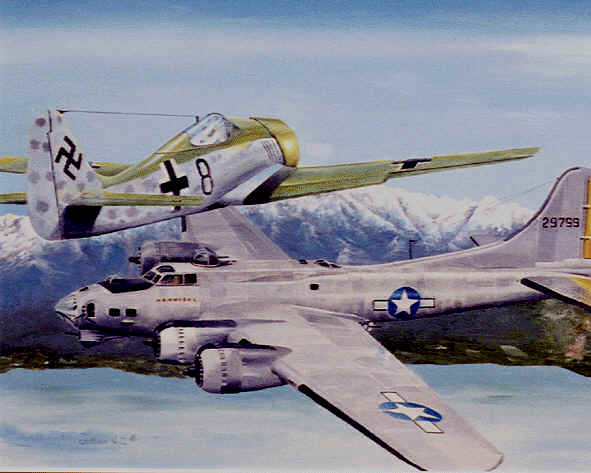


SOLD
The War is Over
30" x 42" x 2", Oil on Canvas, Framed.
The B-17's were used as daylight bombers, and were so engaged when hostilities ended in 1945. A story illustration was told to me about one American bomber pilot, who, on hearing the news, was ordered to finish his mission anyway, but he chose to return to his base without dropping his bombs. As he flew back towards England, they had a chance encounter with a single Focke Wulf... Both the German pilot and the Americans kept their hands off the guns...actually waved...and went home. The war was over.
History: The B-17, arguably World
War It's most famous heavy bomber, first flew on July 28, 1935, before a crowd
of reporters eager to see Boeing's new bomber take wing. It was dubbed the
"Flying Fortress" by the members of the press in attendance because of
its (at least for the time) heavy defensive armament. The prototype crashed in
October, but because of its impressive speed and handling the US Army Air Corps
(USAAC) decided to continue testing anyway. They ordered 13 YB-17s
for further evaluation, a decision that would prove momentous in years to come.
The YB-17 had five machine guns, room for 4,800 pounds of bombs and a crew of
nine. It had electrically retractable landing gear. After testing the YB-17, an
improved prototype, the Y1B-17, was built with Wright
Cyclone radial engines. Twelve were delivered to the USAAC's 2nd Bombardment
Group for trials. One of these was soon equipped with new Moss/General Electric
turbochargers that became standard on all future Flying Fortresses. The first
production order was for 39 B-17Bs with turbo-charged
engines, and as soon as these were under production another order for the B-17C
was placed, with seven machine guns instead of the original five.
The RAF received their first B-17Cs in 1941, and were soon conducting daylight raids over Germany. The defensive armament soon proved inadequate, and the B-17's altitude was little defense against the German fighters. Orders for the B-17D were soon placed with self-sealing fuel tanks and more armor because of lessons learned in bombing missions over Europe. The B-17E and B-17F soon followed with larger tail. The B-17F was the first to serve with the USAAF 8th Air Force. After suffering staggering losses in late 1943, analysis proved head-on attacks by enemy fighters were a distinct problem. The final major version, the B-17G, added a chin turret with dual machineguns. This gave the B-17 a defensive armament of 13 guns.
After the war, several dozen B-17s lived on as
fire-bombers and aerial surveyors until the last one was retired in the 1970s.
Today, a few B-17s have been restored to their wartime splendor. Eleven are
currently flying in the United States, one in the UK and another one in France. [History
by David MacGillivray]
Nicknames: Fort; The Flying Coffin (Nazi propaganda
nickname)
Specifications (B-17G):
Engines: Four 1,200-hp Wright R-1820-97 Cyclone turbocharged radial piston
engines
Weight: Empty 36,135
lbs., Max Takeoff 65,500 lbs.
Wing Span: 103ft. 9in.
Length: 74ft. 4in.
Height: 19ft. 1in.
Performance:
Maximum Speed at 25,000 ft: 287 mph
Cruising Speed: 182 mph
Ceiling: 35,800 ft.
Range:
2,000 miles with 6,000 lb. bomb load
Armament:
13
12.7-mm (0.5-inch) machine guns
Up to
17,600 pounds of bombs
Number Built: ~12, 800+
Number Still Airworthy: 13